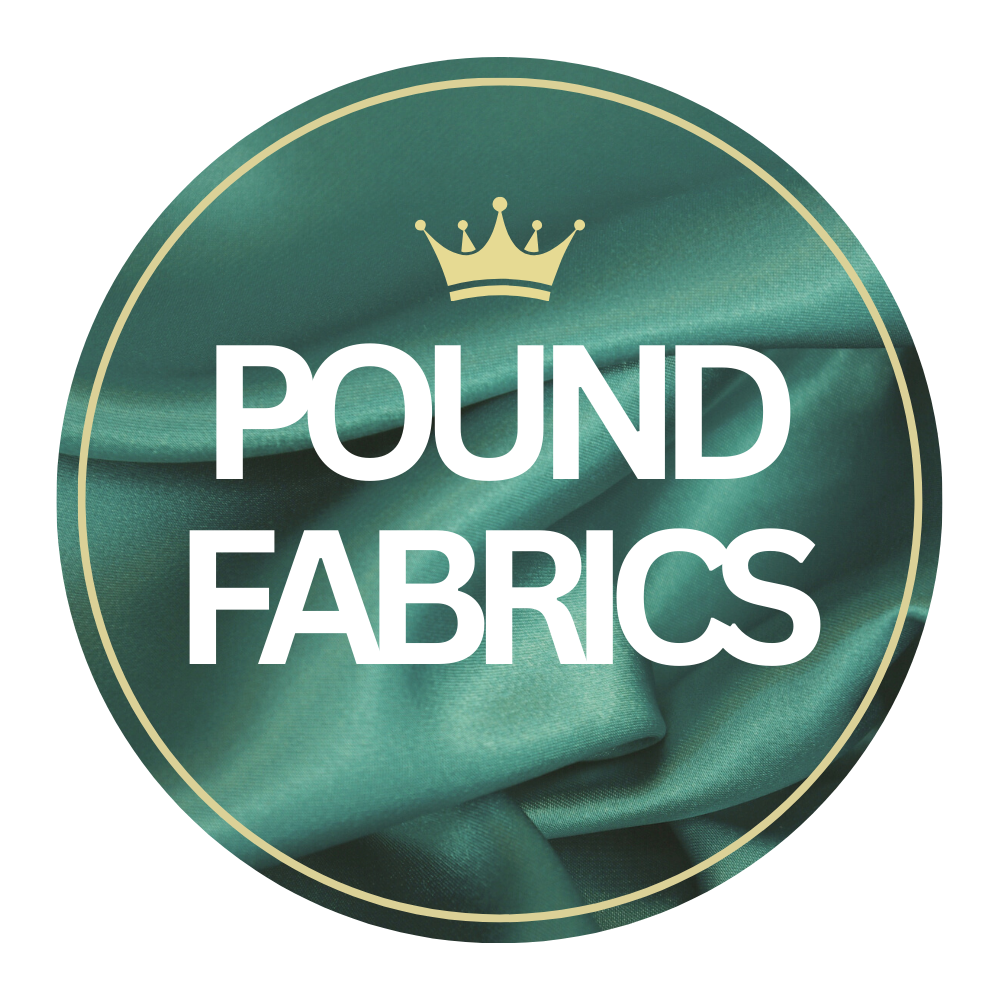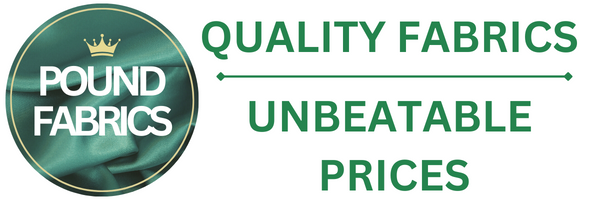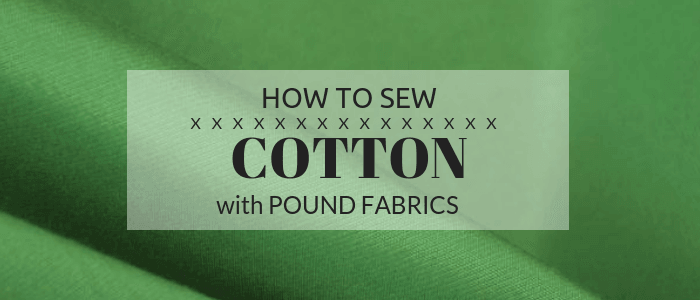
Cotton is an extremely versatile and useful fabric made from natural fibres and is perfect for almost any project. Cotton comes in a variety of weights, colours and finishes. It is also one of the simplest fabrics to work with, meaning your projects will often boast a professional finish with ease. This guide is designed to help make sewing cotton even easier, so that you can utilise this fantastic fabric to its full potential and feel confident creating professional garments.
Origins of cotton
Cotton production dates back to ancient times, with the first historical evidence of its usage and production being traced back to India and Pakistan, approximately around 6,000 BC. Many scientists and historians believe that the first cotton plants were cultivated in the Indus Delta, where the Indus river flows into the Arabian sea in Pakistan. In later years, cotton production and plantations spread across Egypt, Mesopotamia and Nubia.
Cotton did not arrive in Europe until the 1st century, when Arab traders brought over and sold their cotton products and textiles to countries such as Italy and Spain. By medieval times, Northern Europe also had access to the textile through trade.
The country of origin depends on the species of cotton in question. Initially, different varieties were available in America and Asia, then in Africa and the East. By the end of the 16th Century, however, cotton plant cultivation in warmer regions focused around a single species from America, replacing ‘traditional’ cotton species in countries such as Pakistan.
The industrial revolution allowed for the production of cotton textiles to become more simplistic, with the invention of machinery such as the Spinning machine (1700) and the Cotton Gin (1700). These machines enabled a higher quality cotton to be produced much quicker and in larger batches. England’s Manchester affectionately came to be known as ‘Cottonopolis’ due to the mass production of cotton in the city.
Despite textile production being spread across the globe, the central provider of the cotton fibre was India until the 19th Century. However, by then cotton fibre and textile production had established a major industry in North America, where slavery was abused to create a low cost, high profit production industry. American cotton was also much higher in quality, thanks to its longer and stronger fibres. European textile manufacturers then began to purchase Cotton fibre from American plantations, rather than from those in the East.
Modern cotton production now takes place in India, China and Northern America and has become a fairer and more widespread industry with the abolishment of slave trade. Furthermore, much production along the ‘Cotton Belt’ of America (along the Southern states) has ceased as a result of socioeconomic transformations, soil depletion, and the prioritisation of edible crop production, thereby leaving much fibre cultivation to the East.
How is cotton fabric made?
The first major step in cotton production is, unsurprisingly, the cultivation of the crop. This may be done in a variety of ways depending on its region of growth and the species of cotton. As the steps to cultivating cotton plants are quite convoluted and technical, let us begin with the methods with which cotton plants are processed to extract the fibre from the plant.
To begin, the Cotton Gin (mentioned earlier) separates the cotton fibre from the cotton seed. The process is called ‘Ginning’ and begins with the cotton being vacuumed into a dryer, which reduces the moisture content of the plant. The reduction in moisture improves the fibre quality of the cotton, which is then run through a series of cleaning processes to remove any residue, excess vegetation and other foreign objects.
Cotton species with a short fibre length are then ‘ginned’ using a Saw Gin. The saw gin uses circular saws that latch onto the fibres and pull them through narrow slits in the machine. The seeds of the Cotton plant are too big to fit into the slits, thus resulting in the fibre being pulled away from the seed.
Cotton species with a longer fibre length are ginned by a Roller Gin, which uses a slightly different method to separate the fibre, as the longer fibres may be damaged by the previous method. A Roller Gin uses a rough roller to catch the fibre and pulls it under a rotating bar, which has gaps in that are too small for the seed to pass through, separating them from the fibre.
The raw fibre is classed as ‘lint’ once separated from the seed and plant, and will be transferred to a press, where it will be compressed into bales, ready to be sold and woven into textiles. Cotton mills will buy these bales and starting with the raw cotton, will begin the yarn or cloth making process.
The process begins by laying the bales out for processing with a ‘Cotton Opening Machine’. This machine passes over the bales of cotton, pulling out fibres and transporting them to a mixing machine, before being sent to the Carding Machine. Carding is the process of forming a thin web of fibres, by pulling them into alignment. The web is then eventually compacted into a rope-like strand called ‘Sliver’.
The slivers are then put into a combing machine, which removes impurities and any short pieces of Cotton still remaining, resulting in a smooth fibre. The sliver is then drawn or pulled into a longer, thinner strand and twisted to improve its overall strength, then stored on bobbins ready to be spun into yarn.
In modern mills, the slivers are drawn and twisted then placed on larger storage bobbins, called ‘cheese cones’, as yarns. The yarn is then ready to be woven into a textile.
When weaving a textile from cotton, the warp and weft threads must be prepared in slightly different ways. Warp yarns run lengthwise in a woven textile. To prepare the warp yarns for weaving, the yarn strands are wound from the cheese cone onto a large warp beam and coated with a starchy mixture called ‘Sizing Compound’, which adds strength to the yarn. The yarn is then placed onto a loom, ready to be created into cotton.
Weft yarns run crosswise in a woven textile and may sometimes be referred to as ‘filling yarn’. This yarn is not coated with starch as it needs to remain flexible in the weaving process. In most modern mills, the weft yarn is fed into the loom directly from the cheese cones it is stored on, and the fabric is woven using air jets!
There are three basic weaves that may be used to make Cotton fabric;
♣ PLAIN WEAVE
- The most common
- Produced by passing the weft yarn over and under each wrap yarn, alternating with each row
- Used for cotton sheeting and muslin
♣ TWILL WEAVE
- Produced by interlacing the two yarns at an angle, forming straight, diagonal ridges across the cloth
- Used for sturdier textiles like denim, gabardine and ticking
♣ SATIN WEAVE
- Has a different surface texture to most woven fabrics
- Produced with mostly weft yarn that is passed over and under all weft yarn, but with one yarn that stands out slightly against the rest
- Creates a textile with a smooth surface
- Used for upholstery, home decorating and some garments
The finished woven cloth from the loom is often called the ‘grey’, however, it appears white in colour with hints of a natural yellow tint. The cloth may remain as is or be treated to improve both appearance and handle. It may be bleached, dyed, or printed.
Cotton yarn may also be knitted into fabric - the yarns are made into loops, linked using needles. There are two basic methods of knitting cotton fabric;
WET KNIT
- Produced with yarns that form loops on the width of the fabric
- Made on a circular machine
- Makes jersey knit
- Used for T-shirts and underwear
WARP KNIT
- Produced by forming loops in a lengthwise direction
- Makes tricot and cotton lace
- Used for sweaters / jumpers, sportswear and hosiery / underwear
What are the different types of cotton?
There are many different types of Cotton fabric, made from the same fibre, but with very different properties. These are but a few of the many different fabrics that can be made;
BROADCLOTH:A tightly woven Cotton textile, with a slight lustre. This fabric has fine ribs on the surface and resembles a Cotton Poplin. Often used for shirts, blouses and home decorating.
CANVAS:A woven Cotton textile, with a rugged finish. This fabric is made using course yarn and is sometimes called Duck! Used for cushions, slipcovers and upholstery.
CHAMBRAY:A Cotton fabric woven using a mixture of coloured and white yarn. Used for curtains, shirts and dresses.
CHENILLE:A fluffy Cotton fabric that has a slight pile. Used for upholstery, bedspreads and robes.
CHINTZ:A Cotton fabric with a slight glaze, often covered with floral designs and stripes. Used for upholstery, curtains and popular for country style decor.
CORDUROY:A ribbed Cotton fabric with a slight pile, available in a variety of weights and weave styles. Used for cushions, curtains, bedspreads, jackets and trousers.
DAMASK:A patterned Cotton fabric, made on a jacquard loom. Used for table linen and tea towels.
DENIM:A rugged, durable Cotton fabric. This twill fabric is most popularly manufactured in Indigo Blue. Used for jeans, curtains, jackets and upholstery.
FLANNEL:A plain woven Cotton fabric with a slightly napped surface. Used for pyjamas, nightgowns and bed sheets.
GINGHAM:A woven Cotton, made using dyed yarns to create a check pattern. Used for curtains, clothing and bed sheets.
JACQUARD:A Cotton fabric woven on a jacquard loom, producing elaborate, intricate woven designs. Used for decorative purposes, such as on upholstery or tapestries.
OXFORD:A Cotton fabric made with a plain or basket weave. Used on button-down shirts, bed sheets and other garments.
POPLIN:A fine Cotton fabric, with a slight rib effect across the fabric horizontally. This fabric has a high thread count. Used for bed sheets, shirts, baby clothes and crafts.
SATEEN:A satin-weave Cotton fabric with a smooth surface, that has a slight lustre. Used for bed sheets, tablecloths and curtains.
SEERSUCKER:A lightweight woven Cotton fabric, with a slight crinkle to the surface. The texture is created by altering the tension in the warp yarns. Used for summer suits, sportswear, curtains and bed sheets.
SHEERS (Batiste, Lawn, Organdy, Dotted Swiss and Voile):Finely woven Cotton sheers, some with a crisp finish, others soft. Used for dresses, blouses, curtains and other garments.
TERRY CLOTH:A Cotton fabric with a moisture absorbing loop pile. This pile may cover one or both sides.
TWILL:A durable Cotton fabric, with diagonal lines on the right side. This fabric may have a slight lustre. Used for trousers, upholstery and other garments.
How do you sew cotton?
You will need:
- Cotton fabric
- Thread –Opt for a natural cotton thread
- Dressmaking scissors
- Sharp straight pins
- Sharp hand sewing needles
- Universal machine needle size 90/14 –depending on the type of cotton fabric being used
Cutting cotton:
When cutting any cotton fabric, be sure to use a sharp cutting tool. You may use scissors or a sharp rotary cutter and mat - Cotton is fairly forgiving when it comes to cutting as it often lacks stretch and does not slip during cutting or pinning. You will need to use pins or pattern weights when cutting out any pattern pieces - many people find that pins work just fine so there is no need to rush to buy pattern weights! Unless your cotton fabric is particularly weighty or textured, you can cut it in folded or multiple layers, and still produce an accurate cut so long as pins or weights are used.
Stitching cotton:
Cotton is possibly one of the simplest fabrics to work with, as you can use a standard universal needle and pin and cut everything relatively easily. To sew on a machine, use a Universal Machine needle, in a size which reflects the weight of your fabric - we recommend a standard size 90/14. Make sure you use a sharp, fresh needle as heavier weight cottons can blunt your needle more easily.
When hand-sewing or tacking cotton, use a regular sharps needle. Thread selection should be a 100% cotton thread, or a cotton blend. Ideally, opt for a natural thread if cotton is not available or you require a different finish, as this will match the properties most effectively. This will ensure that the fabric and thread share similar properties, allowing for easier garment aftercare.
You do not need to use a special sewing machine foot to sew cotton - so is the perfect fabric to use as a beginner! A standard stitch length to sew your cotton is recommended, usually around a 3.5mm stitch, but be sure to test this on a sample before sewing your final garment.
Finishing cotton:
Cut edges of cotton and any seam will continue to unravel and fray if left unfinished, with wash and wear. The best way to finish your seams is to overlock them, but if you don't have your own overlocker or serger, you can use a simple zig-zag stitch on your machine to reduce the amount of fraying. To hem your fabric, use a simple single fold, blind hem, as this is the least bulky.
To see our full range of cotton fabrics, please click here.
Make sure to tag us @poundfabrics and show us your creations on Instagram, Facebook and Twitter!
Copyright © 2019 Pound Fabrics. All Rights Reserved











Leave a comment (all fields required)